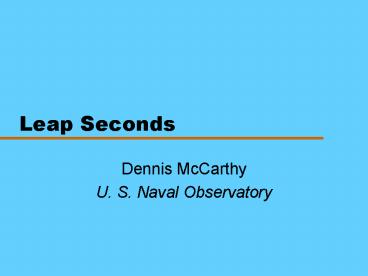Leap Seconds - PowerPoint PPT Presentation
1 / 21
Title: Leap Seconds
1
Leap Seconds
- Dennis McCarthy
- U. S. Naval Observatory
2
Definition of Seconds
- Rotational Second
- 1 / 86,400 of mean solar day
- Ephemeris Second
- First used in 1956
- 1/31,556,925.9747 of tropical year 1900
- Length of year based on 19th century astronomical
observations
3
Atomic Second
- SI second 9,192,631,770 periods of the radiation
corresponding to the transition between 2
hyperfine levels of the ground state of the
Cesium 133 atom (adopted 1964) - Realizes the Ephemeris Second
- Frequency based on lunar observations from1954.25
to 1958.25
SI second preserves the rotational second of
mid-nineteenth century
4
Time Scales
- Rotational
- UT1 is modern realization of historical
astronomical time scales including - Mean Solar Time
- Greenwich Mean Time
- Greenwich Civil Time
- Universal Time (without suffixes)
- Weltzeit
5
Time Scales (continued)
- Atomic
- TAI (International Atomic Time)
- Follow-on from
- A.1 (maintained at USNO with input from 9 other
laboratories originally. - now only USNO) - AM (at BIH with input from many laboratories)
- A3
- at BIH with input from 3 best laboratories
- became AT (or TA) in 1969, TAI in 1971
- others
- All atomic time scales were made equal to UT1
corrected for seasonal effects on 1 Jan 1958 0h
0m 0s - may be considered modern realization of
Ephemeris Time (offset in epoch)
6
Earth Rotation
- Well documented deceleration
- Tidal
- Change in figure
7
Historical Answers
- UTC (Coordinated Universal Time)
- Begun in 1960 as cooperative effort of U.S. Naval
Observatory and Royal Greenwich Observatory to
make coordinated changes to clocks - in 1965 BIH defined UTC with respect to atomic
time - Epoch and frequency adjusted to match UT1
corrected for seasonal variations - Current UTC adopted beginning in 1972
- no changes in frequency
- leap seconds so that UTC-UT1 lt 0.9 s
UTC consistent with previous definitions of legal
time
8
TAI-UTC
9
Causes for Concern
- Frequency of leap seconds increasing
- Increasing public annoyance
- Software issues
- Unpredictable
- Continuous second counts days with 86,401
seconds - Time stamping 23h 59m 60s
- Communications problems
- coordination of events during a leap second
- Growth of systems based on independent time scales
10
Things to Consider
- Navigation
- 1 second 1/4 mile at the equator
- Computer software
- Continuous second counts? 61-second minute?
- Communications
- Maintain synchronization over the leap second?
- Legal definitions
- Mean solar time?
- Religious observances
- Sunrise, noon, sunset?
11
Options
- Status quo
- Discontinue leap seconds
- Use TAI
- Re-define second
- Increase tolerance for UTC-UT1
- Smooth over the leap second step
- Predictable periodic adjustment of UTC
- Conventional adjustment of UTC
- Every leap year? Every 10 years?
- Predict leap seconds based on deceleration model
12
Status Quo
- Pro
- No changes required
- Minimize concerns of celestial navigators
- Con
- Frequency of leap seconds increasing
- Communications, software problems
- Growth of systems based on independent time scales
13
Discontinue Leap Seconds
- Pro
- Eliminate causes for concern
- Con
- Unlimited growth of UTC-UT1
- Legal definitions of time?
14
Use TAI
- Similar to elimination of leap seconds
- TAI must be more accessible
- Pro
- Eliminate causes for concern
- Con
- TAI must be more accessible
- Legal definitions of time?
15
Redefine the Second
- Pro
- Fundamental Solution
- Con
- Require redefinition of physical units
- Temporary solution
16
Smooth Over Leap Second Step
- Pro
- Eliminates the extra second
- Con
- Requires seconds of different lengths
- Date of adjustment unpredictable
- Implementation?
17
Increase Tolerance for UTC-UT1
- Pro
- Easy to accomplish
- Con
- Larger discontinuities
- DUT1 code limitations
- Date of adjustment unpredictable
- What is an acceptable limit?
18
Periodic Adjustment of UTC
- Pro
- Date of adjustment is predictable
- Con
- Number of leap seconds remains unpredictable
- Large discontinuities
19
Conventional Adjustment of UTC
- Unknown number of leap seconds at predictable
intervals
- Known number of leap seconds at predictable
intervals
20
Conventional Adjustment of UTC
21
What to do?
- Question needs study
- URSI
- IAU
- ITU-R































